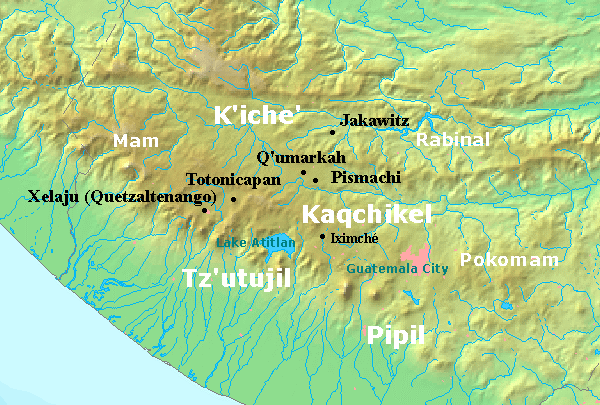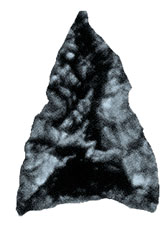|
Mixco Viejo
Mixco Viejo () ("Old Mixco"), occasionally spelt Jilotepeque Viejo, is an archaeological site in the north east of the Chimaltenango department of Guatemala, some to the north of Guatemala City and from the junction of the rivers Pixcaya and Motagua. It is a moderate sized ruined city of the Postclassic Maya civilization. The archaeological site and tourist attraction of Mixco Viejo was named after being erroneously associated with the Postclassic Poqomam capital referred to in colonial records by that name. The archaeological site has now been identified as Jilotepeque Viejo, the capital of the Chajoma kingdom. To distinguish between the two, the ruins of the Chajoma capital are now referred to as Mixco Viejo (Jilotepeque Viejo) while the former Poqomam capital is referred to as Mixco Viejo (Chinautla Viejo). This confusion in the identification of the site has hindered study. The Chajoma capital has been investigated archaeologically, under the assumption that it was ... [...More Info...] [...Related Items...] OR: [Wikipedia] [Google] [Baidu] |
Iximche
Iximcheʼ () (or Iximché using Spanish orthography) is a Pre-Columbian Mesoamerican archaeological site in the western highlands of Guatemala. Iximche was the capital of the Late Postclassic Kaqchikel Maya kingdom from 1470 until its abandonment in 1524. The architecture of the site included a number of pyramid-temples, palaces and two Mesoamerican ballcourts. Excavators uncovered the poorly preserved remains of painted murals on some of the buildings and ample evidence of human sacrifice. The ruins of Iximche were declared a Guatemalan National Monument in the 1960s.Centro de Acción Legal - Ambiental y Social de Guatemala (CALAS). The site has a small museum displaying a number of pieces found there, including sculptures and ceramics. It is open daily. For many years the Kaqchikel served as loyal allies of the Kʼicheʼ Maya.Schele & Mathews 1999, p.295. The growing power of the Kaqchikel within the alliance eventually caused such friction that the Kaqchikel were forced ... [...More Info...] [...Related Items...] OR: [Wikipedia] [Google] [Baidu] |
Departments Of Guatemala
The Guatemala, Republic of Guatemala is divided into 22 Department (country subdivision), departments (Spanish language, Spanish: ''departamentos'') which in turn are divided into 340 Municipalities of Guatemala, municipalities. The departments are governed by a departmental governor, appointed by the President of Guatemala, President. In addition, Guatemala has claimed that all or part of the nation of Belize is a department of Guatemala, and this claim is sometimes reflected in maps of the region. Guatemala formally recognized Belize in 1991, but the Belizean–Guatemalan territorial dispute, border disputes between the two nations have not been resolved. Evolution of Guatemala's territorial organization * 19th century - The department surrounding British Honduras is called Verapaz by the British * 1825 - The first seven departments officially established. Verapaz, Chiquimula, Guatemala/Escuintla, Sacatepéquez/Chimaltenango, Soconusco, Totonicapán/Huehuetenango, and Such ... [...More Info...] [...Related Items...] OR: [Wikipedia] [Google] [Baidu] |
Museum
A museum is an institution dedicated to displaying or Preservation (library and archive), preserving culturally or scientifically significant objects. Many museums have exhibitions of these objects on public display, and some have private collections that are used by researchers and specialists. Museums host a much wider range of objects than a library, and they usually focus on a specific theme, such as the art museums, arts, science museums, science, natural history museums, natural history or Local museum, local history. Public museums that host exhibitions and interactive demonstrations are often tourist attractions, and many draw large numbers of visitors from outside of their host country, with the List of most-visited museums, most visited museums in the world attracting millions of visitors annually. Since the establishment of Ennigaldi-Nanna's museum, the earliest known museum in ancient history, ancient times, museums have been associated with academia and the preserva ... [...More Info...] [...Related Items...] OR: [Wikipedia] [Google] [Baidu] |
Obsidian Use In Mesoamerica
Obsidian is a naturally formed volcanic glass that was an important part of the material culture of Pre-Columbian Mesoamerica. Obsidian was a highly integrated part of daily and ritual life, and its widespread and varied use may be a significant contributor to Mesoamerica's lack of metallurgy. Lithic and contextual analysis of obsidian, including source studies, are important components of archaeological studies of past Mesoamerican cultures and inform scholars on economy, technological organization, long-distance trade, ritual organization, and socio-cultural structure. Production techniques Due to its glassy internal structure, obsidian is relatively easy to work, as it breaks in very predictable and controlled ways via conchoidal fracturing. This contributed to its prolific use throughout Mesoamerica. It is obtained by either quarrying source sites or in nodule form from riverbeds or fractured outcrops. Following the removal of cortex (when applicable), bifacial, uni ... [...More Info...] [...Related Items...] OR: [Wikipedia] [Google] [Baidu] |
CNRS
The French National Centre for Scientific Research (, , CNRS) is the French state research organisation and is the largest fundamental science agency in Europe. In 2016, it employed 31,637 staff, including 11,137 tenured researchers, 13,415 engineers and technical staff, and 7,085 contractual workers. It is headquartered in Paris and has administrative offices in Brussels, Beijing, Tokyo, Singapore, Washington, D.C., Bonn, Moscow, Tunis, Johannesburg, Santiago de Chile, Israel, and New Delhi. Organization The CNRS operates on the basis of research units, which are of two kinds: "proper units" (UPRs) are operated solely by the CNRS, and Joint Research Units (UMRs – ) are run in association with other institutions, such as universities or INSERM. Members of Joint Research Units may be either CNRS researchers or university employees ( ''maîtres de conférences'' or ''professeurs''). Each research unit has a numeric code attached and is typically headed by a university profe ... [...More Info...] [...Related Items...] OR: [Wikipedia] [Google] [Baidu] |
Chimaltenango Department
Chimaltenango is a department of Guatemala. The capital is Chimaltenango. Geography Located to the east are Guatemala Department, home to Guatemala City, and Sacatepéquez Department, while also bordered by Quiché Department and Baja Verapaz Department to the north, Escuintla Department and Suchitepéquez Department to the south, and Sololá Department to the west. The capital of Chimaltenango is located about 54 kilometers away from Guatemala City. In addition to the city of Chimaltenango, the department contains the towns of Santa Apolonia (known for its ceramics), San Juan Comalapa, and Patzún (known for its elaborate Corpus Christi celebrations in June). Chimaltenango is also home to the Maya civilization ruins of Iximché and Mixco Viejo, in addition to many smaller sites. Demographics As of the 2018 census, the population of Chimaltenango department was 615,776. The majority of the people in the department are of Cakchiquel Maya descent. The department has an ... [...More Info...] [...Related Items...] OR: [Wikipedia] [Google] [Baidu] |
San Juan Sacatepéquez
San Juan Sacatepéquez () is a city, with a population of 155,965 (2018 census) Population of the major cities in Guatemala making it the eighth largest in Guatemala, and a in the Guatemala department of , northwest of . The city is known for flower-growing and wooden furniture. Histor ...
|
Mesoamerica
Mesoamerica is a historical region and cultural area that begins in the southern part of North America and extends to the Pacific coast of Central America, thus comprising the lands of central and southern Mexico, all of Belize, Guatemala, El Salvador, and parts of Honduras, Nicaragua and northwestern part of Costa Rica. As a cultural area, Mesoamerica is defined by a mosaic of cultural traits developed and shared by its indigenous cultures. In the pre-Columbian era, many Indigenous peoples of the Americas, indigenous societies flourished in Mesoamerica for more than 3,000 years before the Spanish colonization of the Americas began on Hispaniola in 1493. In world history, Mesoamerica was the site of two historical transformations: (i) primary urban generation, and (ii) the formation of New World cultures from the mixtures of the indigenous Mesoamerican peoples with the European, African, and Asian peoples who were introduced by the Spanish colonization of the Americas. Mesoameri ... [...More Info...] [...Related Items...] OR: [Wikipedia] [Google] [Baidu] |
Conquistador
Conquistadors (, ) or conquistadores (; ; ) were Spanish Empire, Spanish and Portuguese Empire, Portuguese colonizers who explored, traded with and colonized parts of the Americas, Africa, Oceania and Asia during the Age of Discovery. Sailing beyond the Iberian Peninsula, they established numerous Colony, colonies and trade routes, and brought much of the "New World" under the dominion of Spain and Portugal. After Christopher Columbus's arrival in the West Indies in 1492, the Spanish, usually led by Hidalgo (nobility), hidalgos from the west and south of Spain, began building a colonial empire in the Caribbean using colonies such as Captaincy General of Santo Domingo, Santo Domingo, Captaincy General of Cuba, Cuba, and Captaincy General of Puerto Rico, Puerto Rico as their main bases. From 1519 to 1521, Hernán Cortés led the Spanish conquest of the Aztec Empire, ruled by Moctezuma II. From the territories of the Aztec Empire, conquistadors expanded Spanish rule to northern Ce ... [...More Info...] [...Related Items...] OR: [Wikipedia] [Google] [Baidu] |
Tlaxcaltec
The Tlaxcallans, or Tlaxcaltec, are an indigenous Nahua people who originate from Tlaxcala, Mexico. The Confederacy of Tlaxcala was instrumental in overthrowing the Aztec Empire in 1521, alongside conquistadors from the Kingdom of Spain. The Tlaxcallans remained allies of the Spanish for 300 years until the Independence of Mexico in 1821. Pre-Colonial history The Tlaxcaltec were a Nahua group, one of the 7 tribes which migrated from their original homeland in the north alongside the Mexica and 5 other tribes. After settling in what is now called Tlaxcala they formed a conglomeration of three distinct ethnic groups who spoke Nahuatl, Otomi and Pinome that comprised the four city-states (''Altepetl'') of ''Tlaxcallān'' or Tlaxcala. Each of the four cities supposedly had equal say in this confederation, but eventually, the Nahuatl speakers became the dominant ethnic group. By the time of European contact, the city of Tizatlan was effectively controlling Tlaxcala. Despite ea ... [...More Info...] [...Related Items...] OR: [Wikipedia] [Google] [Baidu] |





